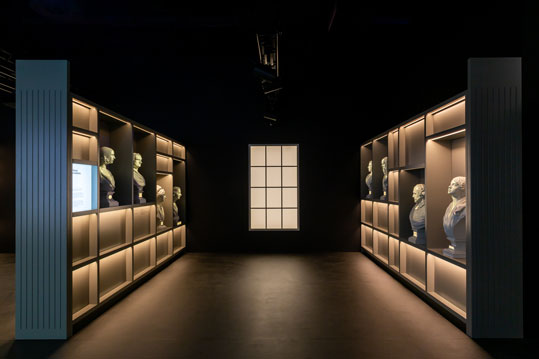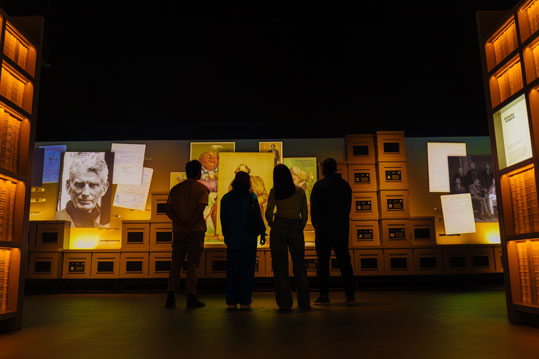Trinity College, Dublin
By Donal Fallon
The Book of Kells is a national treasure, but within the library system of Trinity College, Dublin, it’s known by another name: IE TCD MS 58. It forms the central part of a collection of millions of works on campus, reflecting the unique nature of what is the largest library in Ireland. A legal deposit library since 1801, the university also houses one of the most impressive archival collections in Ireland, home to materials as diverse as the 1641 Depositions and a unique collection of materials relating to Cuala Press and the Irish Arts and Crafts movement.

Dublin, like any city, has its share of myths. One of the most enduring concerns the Book of Kells. ‘Every day, a page is turned’, one 2002 guidebook to Dublin told American readers, ‘so visitors see something new each time they visit’. In truth, it remains a closely guarded secret on campus just how frequently a page is unveiled. While the book has been digitised (see www.digitalcollections.tcd.ie), seeing it in person remains one of the great moments that Dublin offers to visitors. The book itself is eternal—but the setting in which visitors encounter it is changing in the years ahead.
The Book of Kells Experience is—as the name would suggest—not a museum, yet visitors to the university campus over the next roughly two-year period have a unique opportunity to encounter two very different settings. With the delay of the planned closure of the Old Library (now pushed back until late 2025), a ticket entitles the visitor to explore both Thomas Burgh’s eighteenth-century building and the new arrival on campus, the curious red box that has appeared recently. As one enters the university campus from its Nassau Street entrance, the new structure is visible to the right, instantly catching the eye.
On entering the Old Library there is a great sense of openness, with the previous gift shop giving way to an orientation area. The Old Library maintains the feeling of a museum setting—there are several artefacts displayed in the downstairs contextualisation of the book before we encounter the book itself. Bound in four volumes since 1953 (the work of Roger Powell, recognised as the leading bookbinder of his age), only one volume is currently displayed. What is different from my previous visit is the newly designed treasury and the display case, the work of the Goppion design firm which also designed the cases housing the Mona Lisa and the Crown Jewels. The improved lighting in this space and the plinth displaying the book are welcome additions.
Moving to the Long Room, some clever interventions have been made in the space, with video playing between some of the empty shelves (silent and captioned, maintaining the feel of a library) giving a sense of the restoration work currently under way on the collection. This intervention in the space was quick thinking, remembering that the initial plans for the Book of Kells Experience involved the closing of the Old Library to visitors.
At the end of the Long Room, the artwork ‘Gaia’ by Luke Jerram looms large. A giant globe featuring 120dpi detailed NASA imagery of the earth’s surface, we see the planet floating in a three-dimensional form. While Jerram’s intention was to focus our mind on environmental destruction, in a library that houses thousands upon thousands of manuscripts it can be interpreted in other ways. On these shelves (normally) reside some of the defining texts that our planet has produced.

New additions to the Long Room include four busts honouring female figures, the first in the setting. Not alone is it new that women are commemorated here (particularly impressive is Rowan Gillespie’s tribute to Mary Wollstonecraft) but the way the works were produced is reflective of change too. Wollstonecraft was first modelled in wax before being 3D-scanned. Vera Klute’s tribute to Rosalind Franklin includes Swarovski crystals, referencing her use of X-ray crystallography to research the structure of DNA.
From the Old Library, a short walk past Trinity’s oldest building (the Rubrics, built between 1699 and 1705) brings us to the new structure, housing the Book of Kells Experience. Designed by Event (also responsible for EPIC), this is a vast audiovisual journey that brings the collections of Trinity to life.
That EPIC, in its own way a wonderful audiovisual journey, describes itself as the ‘Irish emigration museum’ poses questions about the very nature of what qualifies as a museum. Ultimately at the heart of a museum are permanent collections and artefacts—and the Book of Kells Experience makes no attempt to describe itself as such. Event has referenced some of the real artefacts within the Old Library in imaginative ways—we meet copies of some of the busts, for example, only here they playfully interact with one another and converse.
While the physical material of the Old Library isn’t present here, the archives and manuscripts across the campus inform the digital content that we see. Playfully, boxes (designed to resemble archive boxes) are stacked before a screen, on which we see dancing characters from Cuala Press broadsheets or encounter famed figures synonymous with the university, such as Samuel Beckett. While Event’s approach has always been to visually engage and entertain, the bedrock of the Book of Kells Experience is real material, respectfully drawn on to create digital content.
For those of us in the museum sector, technological advances can give cause for reflection. It is no longer traditional museums alone that present the past to the public. Indeed, with the extraordinary digitisation of the Book of Kells, one doesn’t even have to visit the country to engage with the manuscript. The important distinction remains that such sites—in the absence of a permanent collection and displayed materials—are something different. While intended as a temporary replacement to the much-loved Old Library, the opportunity to visit a historic library and a cutting-edge audiovisual experience offers a chance to experience the best of both worlds. Perhaps such ‘experiences’ are the future of the past?
Donal Fallon is the presenter of the ‘Three Castles Burning’ podcast and author of Three castles burning: a history of Dublin in twelve streets (New Island Books, 2022).
